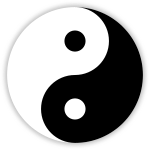
Back Jin en jang Afrikaans اليين واليانغ Arabic য়িন আৰু য়াং Assamese Yin y Yang AST İn və Yan Azerbaijani Yin asin yang BCL Інь і ян Byelorussian Ин-ян Bulgarian ইন এবং ইয়াং Bengali/Bangla Yin ha yang Breton
This article needs additional citations for verification. (June 2023) |
| Yin and yang | |||||||||||||||||||||||||||||||||||||||||||||
|---|---|---|---|---|---|---|---|---|---|---|---|---|---|---|---|---|---|---|---|---|---|---|---|---|---|---|---|---|---|---|---|---|---|---|---|---|---|---|---|---|---|---|---|---|---|
 A taijitu of a particular style that is often named a "yin and yang symbol", the black area representing yin, with the opposite white side representing yang. The dots are representative of one within the other. | |||||||||||||||||||||||||||||||||||||||||||||
| Chinese name | |||||||||||||||||||||||||||||||||||||||||||||
| Traditional Chinese | 陰陽 | ||||||||||||||||||||||||||||||||||||||||||||
| Simplified Chinese | 阴阳 | ||||||||||||||||||||||||||||||||||||||||||||
| |||||||||||||||||||||||||||||||||||||||||||||
| Vietnamese name | |||||||||||||||||||||||||||||||||||||||||||||
| Vietnamese alphabet | âm dương | ||||||||||||||||||||||||||||||||||||||||||||
| Chữ Hán | 陰陽 | ||||||||||||||||||||||||||||||||||||||||||||
| Korean name | |||||||||||||||||||||||||||||||||||||||||||||
| Hangul | 음양 | ||||||||||||||||||||||||||||||||||||||||||||
| Hanja | 陰陽 | ||||||||||||||||||||||||||||||||||||||||||||
| |||||||||||||||||||||||||||||||||||||||||||||
| Mongolian name | |||||||||||||||||||||||||||||||||||||||||||||
| Mongolian Cyrillic | арга билэг / арга билиг | ||||||||||||||||||||||||||||||||||||||||||||
| Mongolian script | ᠡᠠᠷᠭᠠ ᠪᠢᠯᠡᠭ ᠠᠷᠭᠠ ᠪᠢᠯᠢᠭ | ||||||||||||||||||||||||||||||||||||||||||||
| Japanese name | |||||||||||||||||||||||||||||||||||||||||||||
| Kanji | 陰陽 | ||||||||||||||||||||||||||||||||||||||||||||
| Hiragana |
| ||||||||||||||||||||||||||||||||||||||||||||
| Katakana |
| ||||||||||||||||||||||||||||||||||||||||||||
| |||||||||||||||||||||||||||||||||||||||||||||
| Part of a series on |
| Taoism |
|---|
 |
| Part of a series on |
| Chinese folk religion |
|---|
 |
Yin and yang (English: /jɪn/, /jæŋ/), also yinyang[1][2] or yin-yang,[3][2] is a concept that originated in Chinese philosophy, describing an opposite but interconnected, self-perpetuating cycle. Yin and yang can be thought of as complementary and at the same time opposing forces that interact to form a dynamic system in which the whole is greater than the assembled parts and the parts are important for cohesion of the whole.[4]
In Chinese cosmology, the universe creates itself out of a primary chaos of material energy, organized into the cycles of yin and yang, form and matter. 'Yin' is retractive, passive and contractive in nature, while 'yang' is repelling, active and expansive in principle, this dichotomy in some form, is seen in all things in nature—patterns of change and difference, such as biological and seasonal cycles, evolution of the landscape over days, weeks, years and eons (with the original meaning of the words being the north-facing shade and the south-facing brightness of a hill), gender (female and male), as well as the formation of the character of individuals and the grand arc of sociopolitical history in disorder and order.[5]
Taiji is a Chinese cosmological term for the "Supreme Ultimate" state of undifferentiated absolute and infinite potential, the oneness before duality, from which yin and yang originate. It can be contrasted with the older wuji (無極; 'without pole'). In the cosmology pertaining to yin and yang, the material energy which this universe was created from is known as qi. It is believed that the organization of qi in this cosmology of yin and yang has formed the 10 thousand things.[6] Included among these forms are humans. Many natural dualities (such as light and dark, fire and water, expanding and contracting) are thought of as physical manifestations of the duality symbolized by yin and yang. This duality, as a unity of opposites, lies at the origins of many branches of classical Chinese science, technology and philosophy, as well as being a primary guideline of traditional Chinese medicine,[7] and a central principle of different forms of Chinese martial arts and exercise, such as baguazhang, tai chi, daoyin, kung fu and qigong, as well as appearing in the pages of the I Ching and the famous Taoist medical treatise called the Huangdi Neijing
The notion of duality can be found in many areas, such as Communities of Practice. The term "dualistic-monism" or dialectical monism has been coined in an attempt to express this fruitful paradox of simultaneous unity and duality. According to this philosophy, everything has both yin and yang aspects (for instance, shadow cannot exist without light). Either of the two major aspects may manifest more strongly in a particular object, depending on the criterion of the observation. The yin and yang symbol (or taijitu) shows a balance between two opposites with a portion of the opposite element in each section.[citation needed]
In Taoist metaphysics, distinctions between good and bad, along with other dichotomous moral judgments, are perceptual, not real; so, the duality of yin and yang is an indivisible whole. In the ethics of Confucianism on the other hand, most notably in the philosophy of Dong Zhongshu (c. 2nd century BC), a moral dimension is attached to the idea of yin and yang.[8] The Ahom philosophy of duality of the individual self han and pu is quite similar to yin and yang of Taoism.[9] The tradition was originated in Yunnan, China and followed by some Ahom, descendants of Dai ethnic Minority.[10]
- ^ Stefon, Matt (7 May 2021). "yinyang". Encyclopedia Britannica. Retrieved 3 May 2023.
- ^ a b Wang, Robin R. "Yinyang (Yin-yang)". Internet Encyclopedia of Philosophy. Retrieved 3 May 2023.
- ^ Shan, Jun (3 February 2020). "What Do Yin and Yang Represent?". ThoughtCo. Retrieved 3 May 2023.
- ^ Georges Ohsawa (1976). The Unique Principle. George Ohsawa Macrobiotic. ISBN 978-0-918860-17-0 – via Google Books.
- ^ Feuchtwang, Stephan (2016). Religions in the Modern World: Traditions and Transformations. New York: Routledge. p. 150. ISBN 978-0-415-85881-6.
- ^ Feuchtwang, Sephan. "Chinese Religions." Religions in the Modern World: Traditions and Transformations, Third ed., Routledge, 2016, pp. 150–151.
- ^ Porkert, Manfred (1974). The Theoretical Foundations of Chinese Medicine. MIT Press. ISBN 0-262-16058-7.
- ^ Taylor Latener, Rodney Leon (2005). The Illustrated Encyclopedia of Confucianism. Vol. 2. New York: Rosen Publishing Group. p. 869. ISBN 978-0-8239-4079-0.
- ^ Gogoi, Shrutashwinee (2011). Tai ahom religion a philosophical study (PhD). p. vii. hdl:10603/116167.
- ^ Gogoi, Shrutashwinee (2011). Tai ahom religion a philosophical study (PhD). p. 203. hdl:10603/116167.
